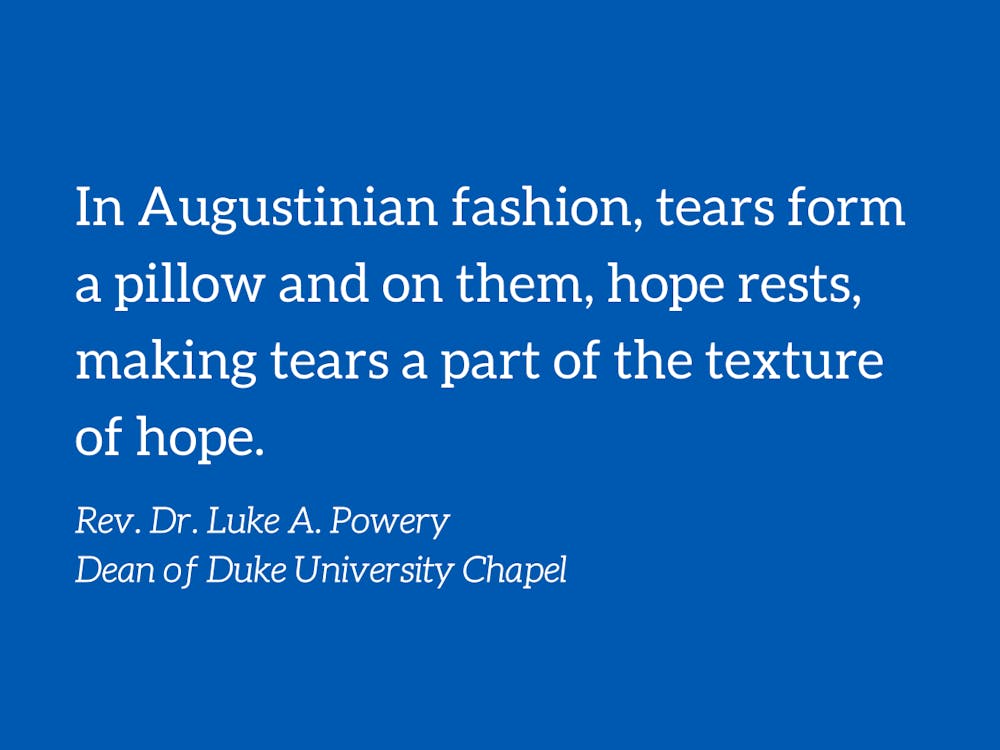People have been crying for hundreds and thousands of years—and their tears have not only expressed grief but also planted seeds of hope.
About 1,600 years ago a young North African man named Augustine, who would become a great bishop and Christian theologian, struggled to mourn when he was by his mother’s side when she expired her last breath. Augustine closed her eyes and as he describes in his book Confessions, “a great wave of sorrow surged into [his] heart.” Tears started to come but he “stemmed the flow” and the tears dried up. He thought it was more mature to put his “sobs in check” and not mark his mother’s death in that way because it was not total extinction or misery since she was a woman of faith. He fought against the wave of emotional sorrow and didn’t even shed a tear at the burial ground. It wasn’t until he woke up the next morning that he wept for her and himself and wrote, “The tears which I have been holding back streamed down, and I let them flow as freely as they would, making of them a pillow for my heart. On them it rested….” His heart rests on a pillow of tears, that is, on grief.
There is still so much to grieve in our world today. All of the uncertainty. All of the fear. All of the anguish. All of the pain. All of the tension, politically, socially and racially. All of the loss, economically and physically. There are now more than 200,000 deaths due to the vicious virus known as COVID-19. Lives are cut too short by a virus or a law enforcement bullet in another Black body, like Breonna Taylor’s.
Like Augustine’s initial approach to grief, some people may want to prevent their tears from flowing even in the face of suffering and death. Within traditional notions of masculinity and a machismo mentality, we hear that “real men don’t cry.” This is bogus philosophy and a myopic view of the full spectrum of human experience. During this challenging time, even at Duke, you might encounter people steeped in sorrow, loneliness, isolation and hurt. Tears might be their food day and night. And there’s nothing wrong with this, because at some point in our lives, we all will travel a path of tears.
About 1,000 years before Augustine, the Hebrew Prophet Jeremiah traveled a road of sorrow and anguish and did so courageously and honestly. He didn’t avoid the abyss but faced it. He was not afraid to grieve, moan and groan. He was not afraid to face the pain of his people or his own suffering and shed tears as a path of solidarity with those who were suffering. This is why he’s known as the weeping prophet.
Tears are a part of his prophetic work and actually, there is much fruit from tears. As one Yiddish proverb says, "What soap is for the baby, tears are for the soul." Jeremiah’s tear-filled grief was prophetic because he refused to be silent in the face of horror and terror and injustice. He didn’t shrink back from voicing the raw grief of life. Tears can represent a torn heart, but this type of tear-filled grief and pathos is also a form of social criticism. One may shed tears because one refuses to shrink back from struggle and pain and injustice. Joy may be gone but hope is not.
Prophets like Jeremiah are prisoners of hope. Their jeers and tears are rooted in a hope in God. Those who do not grieve cannot truly hope because weeping waters the soil for a new life to emerge. The tears flowing from Jeremiah’s head are not a sign of weakness but strength of spirit in the Spirit. All of this weeping and lamentation doesn’t represent an erosion of hope but necessary elements of hope. In Augustinian fashion, tears form a pillow and on them, hope rests, making tears a part of the texture of hope.
One insight into this comes from part of the story of Jeremiah when we are told God refers to Godself as a “fountain of living water” and the people use “cracked cisterns that can hold no water” (Jeremiah 2:13). Later Jeremiah moans his mourning: “O that my head were a spring of water, and my eyes a fountain of tears, so that I might weep day and night for the slain of my poor people!” (Jeremiah 9:1). His weeping then suggests the presence of the divine—that God is in his tears, in the water of holy weeping. This means that hope is tear-stained. If not, it is not real hope because tears sow the seeds of hope. I can’t help but believe as a minister that God is in our tears.
Closer to our own time, Pauli Murray, Durham’s own poet and civil rights leader, has said, “Hope is a song in a weary throat.” Or, as the influential American pastor and preacher J. Alfred Smith has proclaimed, “hope is a tiny sprout growing in cracked concrete.” That means the tears, the suffering, the weary throat, the cracked concrete are the settings out of which hope is born. Hope comes amid our grief, despite our grief, but not without it. Hope is tinged with the ashes of despair and resides in and rises out of the ruins of human life.
So, go ahead and cry, and don’t underestimate tears because they may not mean what you think. They may be a pillow for a heart filling with hope. They may reveal that you are actually a prophet who sows tears and reaps hope. Your tears can be a sign of hope.
Rev. Dr. Luke A. Powery is the Dean of Duke University Chapel. His column runs on alternate Mondays.
Get The Chronicle straight to your inbox
Signup for our weekly newsletter. Cancel at any time.

